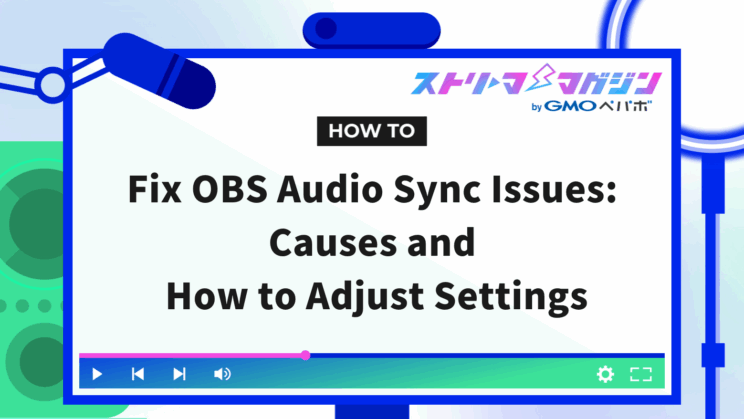Fix OBS Audio Sync Issues: Causes and How to Adjust Settings

Index
- What is Audio Desynchronization in OBS Streaming?
- What Causes Audio Desynchronization in OBS?
- How to Fix Improper Settings in OBS
- OBS Configuration Method 1: Adjust Timestamp Settings
- OBS Configuration Method 2: Set the Sampling Rate Appropriately
- OBS Configuration Method 3: Reconfigure the Frame Rate
- OBS Configuration Method 4: Set to Prevent Dropped Frames
- OBS Configuration Method 5: Change Settings to Prevent Frame Drops
- OBS Configuration Method 6: Change Settings When Using a Capture Board
- Solving Issues on the PC Side
- Solutions for Device Connection Problems
- Frequently Asked Questions About OBS Audio Desynchronization
When using OBS, you may experience audio desynchronization issues. Audio desynchronization occurs when the timing of the video and audio do not match. This article will explain the main causes of this issue and provide simple solutions that you can easily implement. Let’s see how to fix audio desynchronization in OBS.
What is Audio Desynchronization in OBS Streaming?
“Audio desynchronization” refers to the phenomenon where the timing between the video and audio becomes misaligned. This problem can occur in virtually any streaming format that uses OBS, such as PC games or live broadcasts.
In the case of gaming streams or commentary videos, viewers may easily notice the discrepancy with the operations, which can cause them stress and even lead to viewer drop-off. Proper settings and device management are essential to prevent audio desynchronization.
What Causes Audio Desynchronization in OBS?
There are various reasons why audio desynchronization occurs in OBS, but the following three are the main reasons.
1. Improper OBS settings
2. Inadequate PC performance
3. Malfunction of connected devices
Let’s explain each cause in detail.
Cause 1: Improper OBS Settings
If the internal settings of OBS are inappropriate, it may lead to audio desynchronization.
A common issue is the mismatch of “sampling rates”. If the sampling rate set on the PC’s audio device differs from the one set in OBS, audio desynchronization occurs. Also, when using Variable Frame Rate (VFR), since the number of frames in the video is not constant, synchronization with the audio can be misaligned.
Additionally, errors in settings for capture boards or audio interfaces can also cause audio desynchronization, so be cautious. If video and audio are sourced from different devices, incorrect source settings in OBS can prevent synchronization, leading to misalignment.
Cause 2: Inadequate PC Performance
If your PC’s performance is lacking, it may not be able to keep up with processing, leading to audio desynchronization.
OBS processes both video and audio simultaneously, putting a significant load on the CPU and memory. Particularly with older or low-spec PCs, increased CPU usage may delay processing, making audio desynchronization more likely.
Be careful not to overload the stream settings. Especially when streaming at high-quality settings, if your PC’s specs can’t handle it, it can cause audio desynchronization. Additionally, an unstable internet environment can cause data delays, affecting synchronization between audio and video.
If you are curious about the recommended PC specs for OBS streaming, please refer to the following article.
>>Essential Streaming Gear for Aspiring VTubing: Beginner’s Guide
Cause 3: Malfunction of Connected Devices
Devices connected to OBS, such as cameras and microphones, can also cause audio desynchronization. For example, old microphones or capture boards can more easily result in delays due to decreased performance, so take care.
Also, running unnecessary software during a stream can impact the performance of the connected devices and the entire PC.
How to Fix Improper Settings in OBS
Below, we explain in detail how to fix audio desynchronization related to settings in OBS.
OBS Configuration Method 1: Adjust Timestamp Settings
When using the device’s timestamp in OBS, audio and video synchronization may deteriorate. Follow these steps to review and adjust the settings as needed.
1. Go to the timestamp setting screen
Click on the “…” (ellipsis) next to the audio source (desktop audio or microphone audio) under “Audio Mixer” on the main screen and select “Properties”.
2. Check “Use Device Timestamps”
If there is a checkmark next to “Use Device Timestamps” in the settings screen, uncheck it.
If this method doesn’t resolve the audio desynchronization, it is likely that the cause lies elsewhere, so feel free to revert the settings.
OBS Configuration Method 2: Set the Sampling Rate Appropriately
If the sampling rate between OBS and the PC do not match, audio desynchronization may occur. Review your settings with the steps below.
1. Check OBS’s Sampling Rate
Click “Settings” on the bottom right of the main screen, and select the “Audio” tab. Check the “Sampling Rate” in the menu. Normally, it’s set to “44.1kHz” or “48kHz”.
2. Check the PC’s Sampling Rate
On Windows, go to “Settings” → “System” → “Sound” → “Advanced Sound Options”. Open the properties of the playback or recording device, and check the sampling rate under the “Advanced” tab.
3. Consistent Settings are Important
If the OBS and PC sampling rates do not match, it can cause audio desynchronization. By setting the OBS and PC sampling rates to the same value, many desynchronization issues can be resolved.
Also, set the same value for both playback and recording devices (microphones).
OBS Configuration Method 3: Reconfigure the Frame Rate
Frame rate mismatches are one of the causes of audio desynchronization. Check and properly adjust the settings using the steps below.
1. Check the Monitor’s Refresh Rate
Proceed to “Settings” → “System” → “Display” → “Advanced Display Settings” on Windows. Check the refresh rate, which is typically set to “60Hz”.
2. Adjust OBS’s Frame Rate Settings
In OBS, go to “Settings” → “Video” and select the “Common FPS Values”. Set it to a value that matches your monitor’s refresh rate (e.g., “60fps”) and verify the synchronization of video and audio during streaming or recording.
OBS Configuration Method 4: Set to Prevent Dropped Frames
To address audio desynchronization caused by dropped frames in OBS, follow the steps below.
1. Go to the Frame Drop Check Screen
Click “Dock” at the top of the main screen and select “Statistics”.
2. Check if Frame Drop is Occurring
Check the red frame part on the statistics screen. If the numbers are displayed in red, it indicates that frames are being dropped.
3. Adjust the Bitrate
Click “Settings” at the bottom right of OBS, and select the “Output” tab. Change the bitrate to an appropriate value. For example, when broadcasting on YouTube, setting the audio bitrate to 128Kbps is common.
OBS Configuration Method 5: Change Settings to Prevent Frame Drops
If frame drops are causing audio desynchronization, try adjusting the settings using the steps below.
1. Adjust the Game’s Graphics Settings
Set the resolution and frame rate suitable for streaming. Especially if you are using high resolution or frame rates, consider lowering the values to reduce the PC’s load.
2. Adjust Resolution and Frame Rate
Click “Settings” at the bottom right of OBS, select the “Video” tab, and try setting the resolution and frame rate lower.
OBS Configuration Method 6: Change Settings When Using a Capture Board
Proper settings when using a capture board can improve audio desynchronization issues. Try the following methods.
1. Select “Video Capture Device”
Select “Video Capture Device” from Sources at the bottom of the OBS screen. For new settings, click “+” to add.
2. Check “Audio Output Mode”
Open the capture device properties and ensure “Audio Output Mode” is set to “Capture audio only”. Some capture boards may experience significant desynchronization when set to “Output to Desktop Audio”.
3. Enable Audio Monitoring
Open “Advanced Audio Properties” from the “Audio Mixer” in OBS and select “Monitor Only (Mute Output)” for the relevant audio track. This allows monitoring while maintaining audio synchronization.
4. Use Pass-Through Output
If supported by your capture board, using the pass-through function to listen to game audio directly from the TV or monitor may prevent audio delay issues.
Solving Issues on the PC Side
If the specs or settings of your PC are the cause of audio desynchronization, several methods can improve the situation. We will explain specific solutions.
PC Solution 1: Reduce PC Load
If audio desynchronization occurs due to insufficient PC resources, try the following methods to reduce the load.
1. Close Unnecessary Applications
Close any browsers or software not being used during streaming or recording. If necessary, open the Task Manager to check for unnecessary background processes and terminate them.
2. Restart the PC
Restarting, rather than shutting down, can resolve temporary issues that cause resource shortages.
3. Review OBS Settings
Lowering the output resolution of the stream or setting a lower bitrate can reduce the load on your CPU and memory.
PC Solution 2: Review Sound Settings
If the PC’s sound settings are causing audio desynchronization, check and correct the settings using the steps below.
1. Check Advanced Sound Settings
Navigate to “Settings” → “System” → “Sound” → “Advanced Sound Options” on Windows.
2. Select Playback Device
Select the playback device you are using from the “Playback” tab within “Advanced Sound Options” and click “Properties”.
3. Unify Sampling Rates
Open the “Advanced” tab under “Properties” and set the sampling rate to “24-bit, 44,100Hz” or “24-bit, 48,000Hz”. Then, in OBS, go to “Settings” → “Audio” tab, and select the same sampling rate to unify the settings.
After applying the settings, perform a stream or recording to check if the desynchronization is resolved. Unifying the sampling rate between the PC and OBS is crucial for improving audio and video synchronization.
PC Solution 3: Match OBS Settings to PC Performance
If your PC’s specifications can’t keep up with OBS’s demands, reviewing the settings can prevent audio desynchronization. Adjust with the steps below.
1. Check CPU Load
Select “View” → “Statistics” from OBS’s menu to check CPU usage. If the numbers are displayed in red, it indicates an overload, and settings need to be reviewed.
2. Adjust Audio Bitrate
Open OBS’s “Settings” → “Output” tab, and set the “Audio Bitrate” to an appropriate value. Recommended values may vary by streaming platform; for example, YouTube typically uses 128Kbps.
3. Change Settings to Low Load
In OBS’s “Settings” → “Video”, adjust the resolution and frame rate. For instance, lowering the resolution from 1,920×1,080 to 1,280×720, or changing the frame rate from 60fps to 30fps, can reduce the load on your PC.
By optimizing these settings, you can make the most of your PC’s performance and stabilize OBS operation.
PC Solution 4: Update OBS to the Latest Version
If your OBS version is outdated, bugs might be causing audio desynchronization. Update to the latest version with these steps to resolve the issue.
1. Check OBS Updates
From OBS’s official website or the “Help” menu within the software, select “Check for Updates” to see if the latest version is available.
2. Carry Out the Update
If a new version is available, download and install OBS from the official website. During installation, make sure previous settings are retained.
3. Confirm and Test
After the update is complete, try streaming or recording to see if the audio desynchronization has been resolved. If no improvement is seen, consider other settings or equipment problems.
PC Solution 5: Improve Internet Environment
Instabilities in the internet environment can cause audio desynchronization. Revisiting your network setup with these methods can enhance streaming stability.
1. Check Line Stability
Conduct a speed test to check upload speeds and Ping values. Ensure that you have the speed required for streaming (e.g., over 10Mbps). A high Ping value may indicate a stability issue with the line.
2. Optimize Wi-Fi Environment
Adjusting the router’s placement to use it where the signal is strongest is advisable. If stability is poor, prioritize using a wired connection to avoid delays and disconnections.
3. Consider Changing Line
Upgrading to high-quality optical fiber or a well-performing mobile router can greatly improve internet speed and stability during streaming.
Solutions for Device Connection Problems
If malfunctioning connected devices are causing audio desynchronization, revisiting the settings or adjusting the devices is necessary. Here, we’ll introduce specific solutions related to devices.
Device Solution 1: Reconfigure Sync Offset
If the degree of desynchronization between audio and video is constant, OBS’s sync offset function can easily correct it. Adjust it with the steps below.
1. Go to “Advanced Audio Properties”
Click the gear icon next to the relevant device in the audio mixer, or select “Edit” → “Advanced Audio Properties” from the menu to open the settings screen.
2. Configure Sync Offset
Enter a value in the “Sync Offset (ms)” field on the settings screen. To delay the audio, specify a positive value; to advance it, specify a negative value.
However, the above method is effective when the degree of desynchronization is constant. If the desynchronization gradually varies or is caused by other devices, consider other solutions.
Device Solution 2: Adjust Camera or Microphone Delay
If specific device delays from cameras or microphones cause audio desynchronization, it can be adjusted using the methods below.
1. Check Delay
Check the specification sheet or settings screen of the device you are using to identify the size of the delay.
2. Manually Adjust Settings
Open OBS’s “Advanced Audio Properties” and set the delay value on the relevant audio track’s “Sync Offset”. For example, if the delay is 50ms, entering “50ms” synchronizes the video and audio.
3. Close Unused Software
Conclude any applications or browsers not being used during the stream to relieve the overall load on the PC. This can stabilize device operation and reduce delays.
Device Solution 3: Utilize External Audio Interfaces
The built-in sound card on PCs has processing capacity limitations, which may lead to audio quality and delay constraints. Introducing an external audio interface can improve audio quality and minimize desynchronization.
1. Connect External Audio Interface
Connect the external audio interface to the PC via USB or other connectors. Choose a model that offers fast processing and low delay.
2. Choose the Device in OBS
In OBS, go to “Settings” → “Audio”, and select the external audio interface as the audio device. The processing of audio input is optimized.
3. Leverage Advantages
External audio interfaces can minimize delays while also enhancing audio quality and supporting simultaneous use of multiple devices.
Frequently Asked Questions About OBS Audio Desynchronization
We picked up common questions regarding OBS audio desynchronization and explain the solutions for each.
Question 1: Can Beginners Fix OBS Audio Desynchronization?
Beginners can resolve audio desynchronization issues by isolating and tackling the causes one at a time.
First, reduce the setup to a minimum and verify issues. For example, temporarily disable plugins, virtual audio devices, or capture boards, and check if the desynchronization improves. If a particular device or software is identified as the cause during the isolation process, adjusting the corresponding settings may resolve the issue.
However, if the problem is complex and the cause cannot be identified, or if multiple factors are intertwined, resolving the issue might be challenging. Consulting someone knowledgeable might be an option.
Question 2: Can OBS Audio Desynchronization Be Prevented Even with Insufficient PC Specs?
Even with insufficient PC specs, you can often prevent audio desynchronization by adjusting OBS settings. For example, reducing resolution, frame rates, and the audio bitrate can lessen the CPU’s and memory’s load. From the OBS menu, go to “View” → “Statistics” to check CPU usage, and if it appears in red, revisit the settings.
However, if the PC’s performance is too low or you’re using an old PC, replacing it might be necessary for a fundamental solution.
Question 3: How to Solve Audio Desynchronization on Mac?
When using OBS on a Mac, audio desynchronization issues may occur. The following settings may reduce them.
1. Output Mode Settings
In OBS, go to “Settings” → “Output”, change “Output Mode” to “Advanced”. In the “Stream” tab, set the encoder to “Apple VT H264 Hardware Encoder” and adjust the bitrate to 2,500Kbps and the audio bitrate to 128Kbps.
2. Video Settings
For “Video”, unify “Base Resolution” and “Output Resolution” to “1,280×720” and set the downscale filter to “Lanczos (Sharpening Scaling, 36 Samples)”.
The settings can potentially reduce audio desynchronization.
This article detailed the causes and countermeasures for OBS streaming audio desynchronization. Proper settings allow clear synchronization of audio and video.








